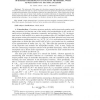SIAMMAX
2010
14 years 7 months ago
2010
The main goal of this paper is to develop a numerical procedure for construction of covariance matrices such that for a given covariance structural model and a discrepancy function...
TSP
2011
14 years 8 months ago
2011
—Radar high-resolution range profiles (HRRPs) are typical high-dimensional, non-Gaussian and interdimension dependently distributed data, the statistical modelling of which is a...
143
click to vote
BMCBI
2010
14 years 8 months ago
2010
Background: Nonparametric Bayesian techniques have been developed recently to extend the sophistication of factor models, allowing one to infer the number of appropriate factors f...
109
click to vote
ICWSM
2009
14 years 10 months ago
2009
This paper contributes to the study of self-presentation in online dating systems by performing a factor analysis on the text portions of online profiles. Findings include a simil...
96
Voted
CORR
2010
Springer
15 years 1 months ago
2010
Springer
Meaning can be generated when information is related at a systemic level. Such a system can be an observer, but also a discourse, for example, operationalized as a set of document...
ICASSP
2010
IEEE
15 years 1 months ago
2010
IEEE
We propose a new method to characterize a speaker within the Joint Factor Analysis (JFA) framework. Scoring within the JFA framework can be costly and a new method was proposed to...
NIPS
2004
15 years 2 months ago
2004
In this paper we present a framework for using multi-layer perceptron (MLP) networks in nonlinear generative models trained by variational Bayesian learning. The nonlinearity is h...
116
click to vote
DATESO
2004
15 years 2 months ago
2004
Binary Factor Analysis (BFA, also known as Boolean Factor Analysis) may help with understanding collections of binary data. Since we can take collections of text documents as binar...
102
click to vote
CLA
2004
15 years 2 months ago
2004
Binary factor analysis (BFA, also known as Boolean Factor Analysis) is a nonhierarchical analysis of binary data, based on reduction of binary space dimension. It allows us to find...
127
click to vote
AUSAI
2007
Springer
15 years 5 months ago
2007
Springer
Factor analysis is a statistical technique for reducing the number of factors responsible for a matrix of correlations to a smaller number of factors that may reflect underlying va...




